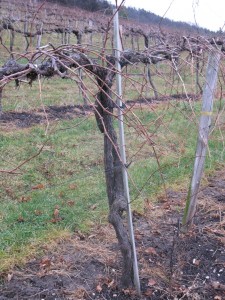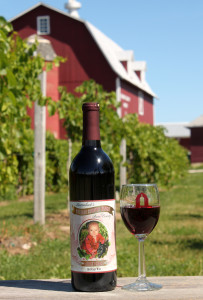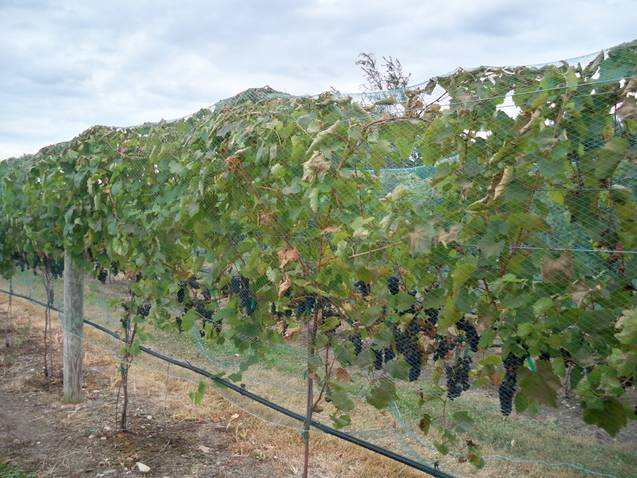Foch Maintains a Midwest Following
When the Marechal Foch wine grape was introduced in 1920, the name “Foch” probably seemed like a winner. At the time, WW I French General Ferdinand Foch was a well know public figure for his role in ending the Great War.
Today, General Foch (pronounced “Fosh”) is all but forgotten except for the European streets that bear his name. The Foch grape has also lost ground. Dozens of red hybrid grapes have been developed in the past 90 years, including Frontenac and Marquette from the University of Minnesota, and they have all taken market share from Foch.
In Illinois, Foch acreage declined 8% from 2007 to 2011. In Wisconsin, only 4% of the new grapes that were planted between 2007 and 2010 were Foch, according to one agricultural survey.
Despite the trend toward new red hybrid grapes, Foch maintains a dedicated following among Midwest wine drinkers and wineries. The largest supporter of Foch is Philippe Coquard who has over 20 acres of the grape at Wollersheim Winery in Prairie Du Sac. With these Wisconsin grown grapes, he produces over 10,000 gallons of Foch wine each year.
“Between myself and Bob Wollersheim (Wollersheim Winery’s founder who died in 20o5) we’ve tried a lot red hybrid grapes, but Foch is the one that is still producing,” Coquard said.
Some of the Foch vines that are still producing at Wollersheim are now 42 years old. Coquard says he continues to plant the grape to satisfy the demand for his seven styles of Foch. “We’ve tried Frontenac,” he said, “and we might consider Marquette, but it would ripen three weeks later than Foch.”
Coquard does not label any of his Foch wines with the varietal name. “When people taste our estate grown red wines, they don’t have any idea that they’re drinking a French American hybrid,” Coquard said. “Unfortunately, there’s a stigma with hybrid wines, but our wines stand on their own merit. The greatest compliment to me is when my father in Beaujolais tastes our wine and says it’s as good as anything from the Rhone Valley or Italy.”
Phillipe’s father is not the only one heaping praise on Wollersheim’s Foch based wines. During 2012, Wollersheim’s Foch won a combined 49 wine contest medals including a Best of Class at the Pacific Rim Wine Competition.
However, few would argue that Foch is the perfect wine grape for the Midwest. Foch vines are prone to early bud break which can wreak havoc. During the spring of 2012, Wollersheim and many other Midwestern Foch growers lost a substantial portion of their crop to a late spring freeze. Foch can also have issues with cold tolerance in the upper Midwest.
Nan Bailly, owner and winemaker of Minnesota’s first winery, Alexis Bailly Vineyard, says that 2,500 vines of Marechal Foch were first planted in their vineyard in 1973. The vines, which are own-rooted and grow on a high wire cordon trellis system, have since been reduced to about 1,500 due to crown gall. This bacterial disease persists even though the Foch vines at Alexis Bailly are buried in the winter to protect them.
For Alexis Bailly, Marechal Foch comprises the majority of their premium red wines. ‘It is the backbone of all our reds, from nouveau to dry red to port. It’s nice to have a low acid grape for blending with the typically high acid grapes developed for cold climates,” Bailly said.
She likes to start with grapes that are in the 22-23 brix range, and reports that she never has trouble fermenting the wine dry, if that’s the goal. ‘It is a versatile grape for all styles of winemaking,” Bailey reports.
At Orchard Country Winery and Market in Fish Creek Wisconsin, Bob Lautenbach not only grows both Foch and Frontenac, he blends the two grapes together. Orchard Country’s “Nathan John” wine contains Frontenac, Foch and Bing Cherry wine. “I think Foch and Frontenac complement one another nicely,” Lautenbach said.
However, in the vineyard, Lautenbach favors Frontenac. “Frontenac is easier to grow than Foch,” he said, “and both the grapes and clusters are bigger on Frontenac.”
However, when it comes to winemaking, Lautenbach likes Foch for its lower acidity. Orchard Country has a varietally labeled Foch called “Audrey Grace” that has no residual sugar. This wine won a Gold Medal at the 2013 Indy International Wine Competition.
Ripening Foch is usually not a problem for Orchard Country which is above the 45th parallel on the Green Bay side of the Door Peninsula. This year Lautenbach picked his Foch in mid-October at 22 Brix, although one block got to 24 Brix, he said.
Lautenbach currently has six acres of wine grapes with four more acres coming on-line next year. The new grape planting will be mainly Marquette, although Lautenbach said he will also add a “few” more Foch vines. He anticipates that the Marquette will not bear fruit as heavily as Foch. Currently, Orchard Country’s seven-year old Foch vines produce an average of three tons per acre.
Directly across Green Bay from Orchard Country Winery, Joe Callow, owner of Forgotten Fire Winery in Marinette, Wisconsin, planted Foch this year on a high wire trellis. Callow has worked with Foch before using grapes imported from New York and Michigan. His Foch wine has “aromas of black fruits, vanilla and musk” according to the winery’s website.
Callow has done test batches with Frontenac and “never really liked it.” He’s planted some Marquette test vines and reports that some small batches are promising.
While Foch is more common in the upper Midwest, it’s also grown father south. Kolin Brighton, production manager at Cedar Ridge Vineyards in Swisher, Iowa near Iowa City, said their 400 Foch vines are own-rooted and grown on a VSP trellis system.
The vigor is usually medium compared to the other nine varietals planted in the vineyard, Brighton said. He also said that Foch is fairly low maintenance, and requires only one hedging just after veraison to achieve proper ripening and an easy harvest.
He adds that it seems to be on the low end of cold hardiness, but this may be due to the location where the grapes are planted, on the end of a small valley where cold air funnels down. He says this becomes an issue during early bud break followed by a late frost; much like the one experienced in 2012 when Cedar Ridge lost 50% of their Foch crop.
Brighton says that their Foch is made in a nouveau style. They usually pick at 20 Brix, and this year they harvested at 21 Brix. Cedar Ridge Foch gets 3-4 days of skin contact followed by two months in new Hungarian oak. It is fermented to 1.5% residual sugar.
‘The light and easy to drink nature of our Foch is what usually gets people to order a bottle,” Brighton said. He adds that it appeals to all ages, but younger drinkers who want to experiment with dry reds find Foch approachable. It is either the best or second best selling wine in their tasting room, depending on the month, with the other top seller being a Reserve Cabernet.






Great article. I still think that Foch beats the competitors (Frontenac, Marquette, Chambourcin) hands down. Like Vignoles (white French-American hybrid), there are many ways the wine can be made and finished. The fact that Foch can work in different growing zones shows its versatility.
I’m surprised you did not talk about Leon Millot (Kuhlmann 192) since it is related to Foch (Kuhlmann 188). I prefer Foch over Millot but Millot has its advocates.
It is reported that older foch vines produce a better grape. That may be born out by wollenshines 42 year old vines. One fall back to foch iw while it is very cold hardy it is susuptable to 2-4–D more than many other variatials. It can take a lot but will be killed or become sterile with moderate doses of 2-4-D & dicammba. Ted